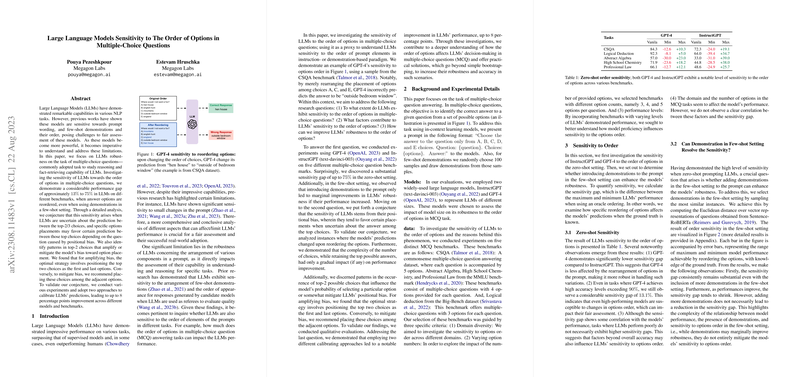Sensitivity of LLMs to Options Order in Multiple-Choice Questions
The investigated article concerns the robustness of LLMs when subjected to multiple-choice questions (MCQs), with a specific focus on how the order of answer options influences model performance. LLMs have gained remarkable traction for their capacity to handle natural language processing tasks, exhibiting competency even beyond certain human capabilities. Despite this, the sensitivity of these models to prompt formulation and sequence arrangements in input data requires further examination.
Sensitivity Implications and Investigation
The authors investigate how the order of options in MCQs modulates the ability of LLMs to make accurate predictions. By conducting experiments with different LLMs, including GPT-4 and InstructGPT, the paper demonstrates a substantial disparity in performance contingent on the sequencing of options. A notable finding is the performance variability ranging between 13% and 75% across different MCQ benchmarks when altering the order of options. This sensitivity raises profound implications for evaluating the reasoning and fact-retrieving skills of LLMs in structured assessments such as MCQs.
Underpinning Factors for Sensitivity
Through detailed analysis, it is posited that this sensitivity emerges primarily due to two factors:
- Uncertainty in Predictions: LLMs often exhibit indecisiveness between the top few choices, indicating inherent uncertainty in selecting the most apt answer when options are semantically similar or close in relevancy.
- Positional Bias: The order of options manifests a significant bias, where LLMs may display a preference for specific answer placements. This is magnified in situations where the model’s confidence in its predictions is low.
The paper uncovers patterns that amplify or mitigate this bias, offering solutions such as strategically placing the most probable answers in adjacent positions to enhance robustness. These findings elucidate an intrinsic aspect of LLM function, revealing vulnerabilities when feedback is structured in a particular order.
Enhancing Model Robustness
To mitigate LLMs' susceptibility to option ordering, the authors propose calibration techniques that include using a majority voting scheme over predictions from various permutations of option orders. Notably, this approach resulted in performance enhancements of up to eight percentage points in some cases. Conversely, attempts at explanation-driven prediction calibration, such as the Multiple Evidence Calibration (MEC) method, yielded contrasting results, particularly adverse for models like InstructGPT.
Future Perspectives and Implications
The insights derived from examining option order sensitivity have tangible implications for the development of LLMs and their application in real-world situations. In practical terms, this implies a need for more sophisticated methods to evaluate LLM capabilities, ensuring that their decisions reflect genuine comprehension rather than positional bias. Moreover, this could influence how datasets, especially those involving structured response formats like MCQs, are designed and interpreted within AI research.
Extending this understanding could lead to considerable advancements in LLM reliability and performance, not just constrained to MCQs but extending to other complex NLP tasks where multiple elements or orderings are involved. As AI models evolve, incorporating nuanced calibration strategies during both training and evaluation phases may lead to more robust AI models capable of consistently strong performance across varied scenarios.
In summary, this research sheds light on an aspect of LLM functioning that has been relatively unexplored and underscores the necessity for ongoing scrutiny and refinement of these models in handling ordered input data. The findings serve as a foundation for future studies aimed at minimizing biases inherent in AI models, propelling forward their application in more diverse and unstructured environments.
